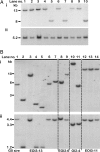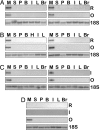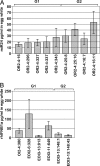Oviduct-specific expression of two therapeutic proteins in transgenic hens
- PMID: 17259305
- PMCID: PMC1783527
- DOI: 10.1073/pnas.0610401104
Oviduct-specific expression of two therapeutic proteins in transgenic hens
Abstract
Recent advances in avian transgenesis have led to the possibility of utilizing the laying hen as a production platform for the large-scale synthesis of pharmaceutical proteins. Ovalbumin constitutes more than half of the protein in the white of a laid egg, and expression of the ovalbumin gene is restricted to the tubular gland cells of the oviduct. Here we describe the use of lentiviral vectors to deliver transgene constructs comprising regulatory sequences from the ovalbumin gene designed to direct synthesis of associated therapeutic proteins to the oviduct. We report the generation of transgenic hens that synthesize functional recombinant pharmaceutical protein in a tightly regulated tissue-specific manner, without any evidence of transgene silencing after germ-line transmission.
Conflict of interest statement
Conflict of interest statement: I.W. was head of division of this group while he was at Roslin Institute, but he will gain no benefit from publication of this paper. The authors declare no conflict of interest.
Figures






Comment in
-
The incredible, edible, and therapeutic egg.Proc Natl Acad Sci U S A. 2007 Feb 6;104(6):1739-40. doi: 10.1073/pnas.0611652104. Epub 2007 Feb 1. Proc Natl Acad Sci U S A. 2007. PMID: 17272493 Free PMC article. No abstract available.
Similar articles
-
Expression of exogenous protein in the egg white of transgenic chickens.Nat Biotechnol. 2002 Apr;20(4):396-9. doi: 10.1038/nbt0402-396. Nat Biotechnol. 2002. PMID: 11923848
-
Production of biofunctional recombinant human interleukin 1 receptor antagonist (rhIL1RN) from transgenic quail egg white.Biol Reprod. 2010 Jun;82(6):1057-64. doi: 10.1095/biolreprod.109.081687. Epub 2010 Feb 10. Biol Reprod. 2010. PMID: 20147736
-
Hens as protein bioreactors.Lab Anim (NY). 2007 Mar;36(3):8. doi: 10.1038/laban0307-8a. Lab Anim (NY). 2007. PMID: 17311035 No abstract available.
-
Competitive bioreactor hens on the horizon.Trends Biotechnol. 2006 Mar;24(3):99-101. doi: 10.1016/j.tibtech.2006.01.004. Epub 2006 Jan 30. Trends Biotechnol. 2006. PMID: 16445998 Review.
-
Transgenic chickens as bioreactors for protein-based drugs.Drug Discov Today. 2005 Feb 1;10(3):191-6. doi: 10.1016/S1359-6446(04)03317-3. Drug Discov Today. 2005. PMID: 15708533 Review.
Cited by
-
The incredible, edible, and therapeutic egg.Proc Natl Acad Sci U S A. 2007 Feb 6;104(6):1739-40. doi: 10.1073/pnas.0611652104. Epub 2007 Feb 1. Proc Natl Acad Sci U S A. 2007. PMID: 17272493 Free PMC article. No abstract available.
-
Applications of Gene Editing in Chickens: A New Era Is on the Horizon.Front Genet. 2018 Oct 9;9:456. doi: 10.3389/fgene.2018.00456. eCollection 2018. Front Genet. 2018. PMID: 30356667 Free PMC article. Review.
-
An ovalbumin fusion strategy to increase recombinant protein secretion in chicken eggs.J Biol Eng. 2024 Jan 11;18(1):5. doi: 10.1186/s13036-023-00390-4. J Biol Eng. 2024. PMID: 38212799 Free PMC article.
-
IgY technology: Methods for developing and evaluating avian immunoglobulins for the in vitro detection of biomolecules.World J Methodol. 2021 Sep 20;11(5):243-262. doi: 10.5662/wjm.v11.i5.243. eCollection 2021 Sep 20. World J Methodol. 2021. PMID: 34631482 Free PMC article. Review.
-
Genetic modification of a chicken expression system for the galactosylation of therapeutic proteins produced in egg white.Transgenic Res. 2012 Feb;21(1):63-75. doi: 10.1007/s11248-011-9511-0. Epub 2011 Apr 13. Transgenic Res. 2012. PMID: 21487777
References
-
- Dyck MK, Lacroix D, Pothier F, Sirard MA. Trends Biotechnol. 2003;21:394–399. - PubMed
-
- Hunter CV, Tiley LS, Sang HM. Trends Mol Med. 2005;11:293–298. - PubMed
-
- Rapp JC, Harvey AJ, Speksnijder GL, Hu W, Ivarie R. Transgenic Res. 2003;12:569–575. - PubMed
-
- Zhu L, van de Lavoir M, Albanese J, Beenhouwer DO, Cardarelli PM, Cuison S, Deng DF, Deshpande S, Diamond JH, et al. Nat Biotechnol. 2005;23:1159–1169. - PubMed
Publication types
MeSH terms
Substances
LinkOut - more resources
Full Text Sources
Other Literature Sources

